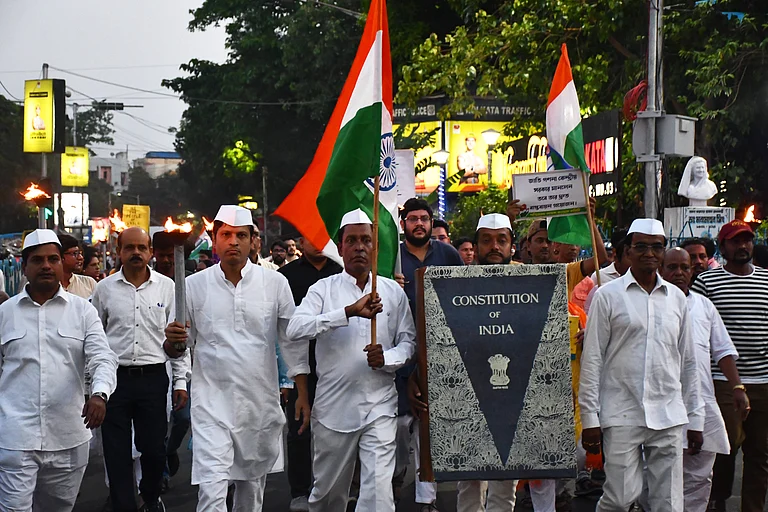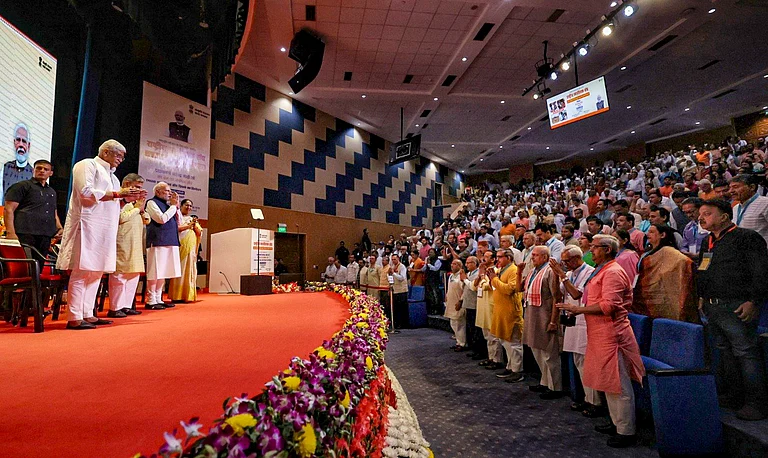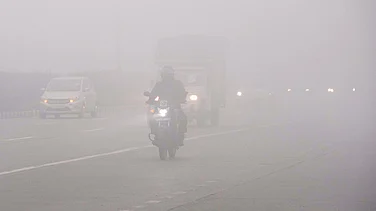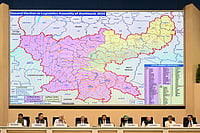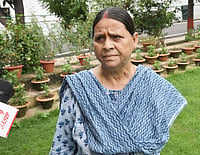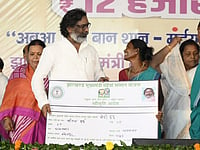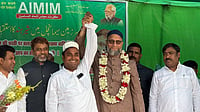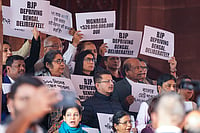
The RSS established its first VKA in Lohardaga in 1969.
In 2023, the JSM organised a massive rally in Ranchi, demanding such a delisting. Oraon played a central role in that rally.
Today, the VKA runs over 100 formal schools, 21,000 service centres for education and health, 16 medical clinics, and more than 5,000 Ekal Vidyalayas in the state. Along with Vikas Bharti’s 300 full-time workers, other RSS-linked groups also operate extensively among Adivasis.
Sandeep Oraon, 50, a resident of Budulia village in Kanke block of Jharkhand, made a choice nearly two decades ago, when, in 2003, he joined the state unit of the Akhil Bharatiya Vanvasi Kalyan Ashram (VKA). An affiliate of the Rashtriya Swayamsevak Sangh (RSS), the organisation has been, for the past 73 years, working for the cause of tribals across India.
For Oraon, it was a matter of preserving his identity. “If I hadn’t joined the VKA, my name would have been Simon instead of Sandeep,” he says, referring to the large-scale religious conversions prevalent across Jharkhand for decades. “That’s the biggest strength of this institution. It allows you (tribals) to remain who you are.”
Two years after joining, he was entrusted with a crucial responsibility in the Janajati Suraksha Manch (JSM)—an RSS initiative that works under the umbrella of the VKA. Its primary demand is to delist Adivasis who have converted to Christianity or Islam from the Scheduled Tribes (ST) category.
In 2023, the JSM organised a massive rally in Ranchi, demanding such a delisting. Oraon played a central role in that rally. Today, he serves as the regional convener for North-Central India, covering Jharkhand and Bihar’s Seemanchal region.
“The JSM safeguards and promotes the cultural, religious and natural identity of tribals and never advocates moving away from them,” Sandeep explains. For him, preventing religious conversion is essential to protecting tribal traditions, because, he argues, conversion poses a serious internal threat.
This stance mirrors that of the RSS and the allied Hindutva organisations. Alarmed by the growing influence of Christian missionaries in tribal society, the RSS established its first VKA in Lohardaga in 1969. By the 1980s, it had expanded to Palamu, Gumla and northern Chotanagpur, setting up a network of schools and health centres. In 1982, social worker Ashok Bhagat founded the NGO Vikas Bharti in Bishunpur, Gumla, to further consolidate the Sangh’s reach among Jharkhand Adivasis. Together, Vikas Bharti and the VKA claim to, directly or indirectly, reach nearly 60 per cent of Jharkhand’s Adivasi population.
Today, the VKA runs over 100 formal schools, 21,000 service centres for education and health, 16 medical clinics, and more than 5,000 Ekal Vidyalayas in the state. Along with Vikas Bharti’s 300 full-time workers, other RSS-linked groups also operate extensively among Adivasis.
Despite such a massive reach, the Bharatiya Janata Party (BJP) has never secured a majority in Jharkhand’s 81-member Assembly. There are several bones of contention—the primary ones being the Sarna Dharma—a distinct tradition of nature worship—and the Sangh Parivar’s insistence on referring to Adivasis as Vanvasis.
While the Adivasi-Vanvasi debate became a political theme during the 2024 Lok Sabha and Jharkhand Assembly elections, the tussle, however, has been going on for decades. Adivasi, translated literally, means original inhabitant. But the RSS and its offshoots, like the VKA, reject the terms Adivasi. According to them, using the word Adivasi is divisive as it indicates that those who are not Adivasis have come from outside, validating the Aryan invasion theory. The fact that the party’s tribal base has steadily eroded reflects that the Adivasis in the state are not aligned with the RSS on this.
Another fundamental point of contention pertains to the Adivasi identity itself. While the formation of the VKA happened over concerns regarding the increasing activities of Christian missionaries in tribal areas, its initial outreach mirrored missionary methods—focusing on health and education rather than ideology. Poverty made tribals receptive to such services. However, in the 1990s, its Hindutva orientation became clearer. For decades, activists of the Sangh and its various affiliates in the region have made consistent attempts to appropriate tribal belief systems into the Hindu fold and to oppose conversion into other religious communities.
“Our enemy has been the missionaries,” says Raghav Rana, a VKA functionary. “They came in the name of service, but soon hung crosses around people’s necks, starting in Chotanagpur. We expanded in other districts to counter them. Today, they accuse us of turning tribals into Hindus. But we never ask them to abandon their culture. Missionaries, on the other hand, push conversion and cultural erasure together,” he adds. The VKA claims presence across all 24 districts and 34 tribal groups in Jharkhand. With the RSS turning 100 on Dussehra this year and the VKA set to mark 75 years next year, the goal is to cover every district fully.
Amid the Hindu-Christianity debate, another front has emerged—tribals who follow Sarna Dharma. It is a nature-based faith practiced by tribal communities in Jharkhand and other states, centred on worshipping natural elements like forests, water and land, and advocating for their protection. Followers of Sarna Dharma believe in sacred groves (Sarna), do not practice idol worship, and consider themselves distinct from the Hindu Varna system.
Nearly five million Indian tribals chose to register themselves as Sarna in the 2011 Census. Over 83 per cent of these, or 4.1 million, were from Jharkhand. Sarna followers reject both the RSS and Christian missionaries, and, for years, have demanded official recognition through a separate Sarna Religion Code.
Incidentally, the Sarna movement gained strength in the 1990s, around the same time the VKA started pushing its Hindu agenda. In 2004, leaders like Chamra Linda—JMM leader and Tribal Minister of Jharkhand—and Bandhan Tigga, a Sarna Dharma guru, organised Sarna Prarthana Sabha, mobilising Adivasis through hostels and village campaigns. Many Adivasis who had once aligned with the VKA, or even considered themselves Hindus, turned toward Sarna. As a result, festivals like Sarhul and Karma, long absent from missionary schools and colleges, began to be celebrated.
The demand for recognition of the Sarna religion in the Census of India has pitted tribal identity politics against majoritarian Hindutva. The RSS insists that Sarna is part of Sanatan Dharma, and therefore opposes a separate code.
The demand has also created a deep schism in Jharkhand politics. Sarna followers—primarily from the Oraon and Munda tribes—are concentrated in regions such as Khunti and Gumla. In these areas, Chief Minister Hemant Soren-led INDIA bloc won tribal-reserved seats in both Lok Sabha and Assembly elections in 2024. Soren pushed the demand for the Sarna Religion Code during his 2019–2024 tenure, passing a Sarna Code Bill in the Jharkhand Assembly and forwarding it to the Centre. Though the Union government has not acted in five years, the movement has certainly shaken the RSS’ agenda of bringing Adivasis under the Hindu fold.
Soma Oraon, 52, is the mukhiya (village head) of Bodia Panchayat in Ranchi. He has been associated with the VKA for the past three years and believes that attempts are being made to separate Adivasis from Sanatan Dharma in the name of Sarna. According to him, if that happens, Adivasis under the Sarna fold will be left only with the right to religious propagation, while all other Scheduled Tribe (ST) rights will be taken away. “Right now, Adivasis are getting certain benefits—like the 26 per cent reservation—because they are categorised under the Hindu fold. Suppose Sarna is recognised as a separate religion, the 26 per cent will be cut down to two per cent and they will be pushed to the lower category,” he explains.
The resistance of the RSS and its affiliates to accept the Sarna Religion Code has not helped them electorally in the state, especially when the BJP’s performance is compared to neighbouring tribal-dominated states. While the party has ruled in Madhya Pradesh for two decades, it has made strong gains on ST-reserved seats in Chhattisgarh and Odisha.
In the 2014 and 2019 Lok Sabha elections, the BJP won 12 of 14 seats but lost three reserved tribal constituencies in 2024, including Khunti and Lohardaga—traditional strongholds. Between 1989 and 2019, it won Khunti eight times and Lohardaga six, but in 2024, the JMM alliance swept 27 of 28 reserved Assembly seats. The BJP’s Assembly performance tells the same story—nine reserved seats in 2005 and 2009, 11 in 2014, two in 2019, and one in 2024.
The Sangh, however, does not see this as a decline in its tribal hold. “Elections involve many factors,” says Rana, the VKA associate. “Soren and the missionaries created an anti-BJP narrative. Assuming that 7–10 per cent of our people shifted, the results changed drastically. Also, the BJP did not coordinate well with us, which left Soren’s narrative unchallenged. The BJP was overconfident, and it cost them.”
Ashok Bhagat of Vikas Bharti, the only RSS outfit working exclusively in Jharkhand’s tribal areas, takes a more nuanced view. Unlike other Sangh organisations, he began by adapting to tribal culture rather than imposing Hindu identity. “When we first started, there were clashes, both with non-tribal forces over land rights and internally within the Sangh,” Bhagat recalls. “For a decade, we faced political hostility. Our approach was never to force Hindutva—whether tribals called themselves Hindus was secondary. What mattered was protecting their pride, traditions, and culture. Even if a village we worked in voted for JMM, we did not interfere. Our goodwill at the grassroots has grown, regardless of the BJP’s electoral fortunes.”
Bhagat believes the BJP’s decline was largely self-inflicted—starting with appointing non-tribal Raghubar Das as Chief Minister, and later pushing amendments to the Chotanagpur Tenancy Act (CNT) and Santhal Pargana Tenancy Act (SPT). The CNT and SPT Acts are two key land reform laws in Jharkhand that protect the rights of tribal communities and restrict land sales to non-tribals. Both moves alienated tribals and even the BJP’s own cadre. “This gave Hemant Soren a walkover in 2019 and 2024,” he says. Bhagat also concedes that the BJP and the RSS failed to take a clear position on the Sarna Code, which further benefited Soren.
Experts note that while Adivasis in Jharkhand may be divided by religion and ideology, they unite when their collective identity is threatened. Time and again, the assertion of tribal identity overrides ideological divides. This perhaps explains why the Sangh has never established as firm a grip in Jharkhand as it has in Madhya Pradesh, Chhattisgarh, or Odisha.
“When you compare Jharkhand’s tribals with those elsewhere, you find them more conscious of their rights and identity,” says Sanjay Basu Mallick, a veteran of the Jharkhand movement. “Remember, before the VKA, Mahatma Gandhi sent his close associate and prominent social worker Thakkar Bapa to Chotanagpur in 1925 to empower tribals. He formed the Sevak Sangh. Gandhi’s aim was integration, while the Sangh sought assimilation into Hinduism. But Jharkhand tribals rejected both, standing firm on their distinct identity.”








